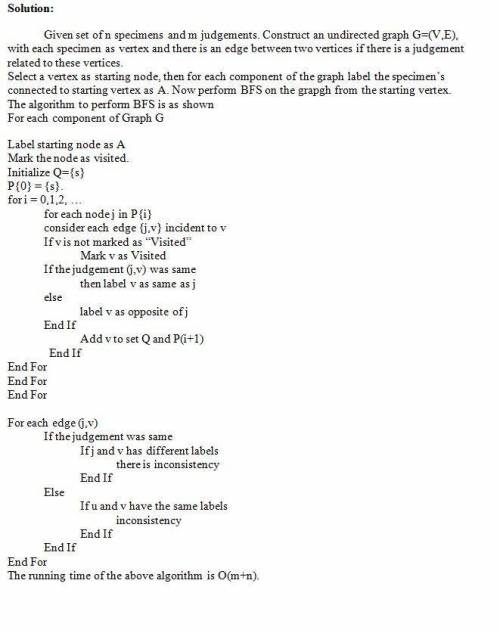
Engineering, 07.03.2020 03:32 surfer89
Inspired by the example of that great Cornellian, VladimirNabokov, some of your friends have become amateur lepidopterists (they study butter- flies). Often when they return from a trip with specimens of butterflies, it is very difficult for them to tell how many distinct species they’ve caught—thanks to the fact that many species look very similar to one another.
One day they return with n butterflies, and they believe that each belongs to one of two different species, which we’ll call A and B for purposes of this discussion. They’d like to divide the n specimens into two groups—those that belong to A and those that belong to B—but it’s very hard for them to directly label any one specimen. So they decide to adopt the following approach.
For each pair of specimens i and j, they study them carefully side by side. If they’re confident enough in their judgment, then they label the pair (i, j) either "same" (meaning they believe them both to come from the same species) or "different" (meaning they believe them to come from different species). They also have the option of rendering no judgment on a given pair, in which case we’ll call the pair ambiguous.
So now they have the collection of n specimens, as well as a collection of m judgments (either "same" or "different") for the pairs that were not declared to be ambiguous. They’d like to know if this data is consistent with the idea that each butterfly is from one of species A or B. So more concretely, we’ll declare the m judgments to be consistent if it is possible to label each specimen either A or B in such a way that for each pair (i, j) labeled "same," it is the case that i and j have the same label; and for each pair (i, j) labeled "different," it is the case that i and j have different labels. They’re in the middle of tediously working out whether their judgments are consistent, when one of them realizes that you probably have an algorithm that would answer this question right away.
Give an algorithm with running time O(m + n) that determines whether the m judgments are consistent.

Answers: 1


Another question on Engineering

Engineering, 04.07.2019 18:10
Afour cylinder four-stroke in-line engine has a stroke of 160mm, connecting rod length of 150mm, a reciprocating mass of 3kg and its firing order is 1-3-4-2. the spacing between cylinders is 100mm. i. show that the engine is in balance with regard to the primary inertia forces and primary 3. a and secondary inertia couples. li determine the out of balance secondary inertia force ii. propose ways of balancing this out of balance force and discuss the challenges that will arise
Answers: 3

Engineering, 04.07.2019 18:10
The thermal expansion or contraction of a given metal is a function of the f a)-density b)-initial temperature c)- temperature difference d)- linear coefficient of thermal expansion e)- final temperature f)- original length
Answers: 2

Engineering, 04.07.2019 18:20
Wiy doeres rere okhn a pump whon working betwon the same pressure range?
Answers: 2

Engineering, 04.07.2019 19:10
What are the major differences between injection molding and extrusion?
Answers: 2
You know the right answer?
Inspired by the example of that great Cornellian, VladimirNabokov, some of your friends have become...
Questions






Mathematics, 06.09.2021 23:30

History, 06.09.2021 23:30

Mathematics, 06.09.2021 23:30


Mathematics, 06.09.2021 23:30



Biology, 06.09.2021 23:30

Advanced Placement (AP), 06.09.2021 23:30

Mathematics, 06.09.2021 23:30

Mathematics, 06.09.2021 23:30




Mathematics, 06.09.2021 23:30




